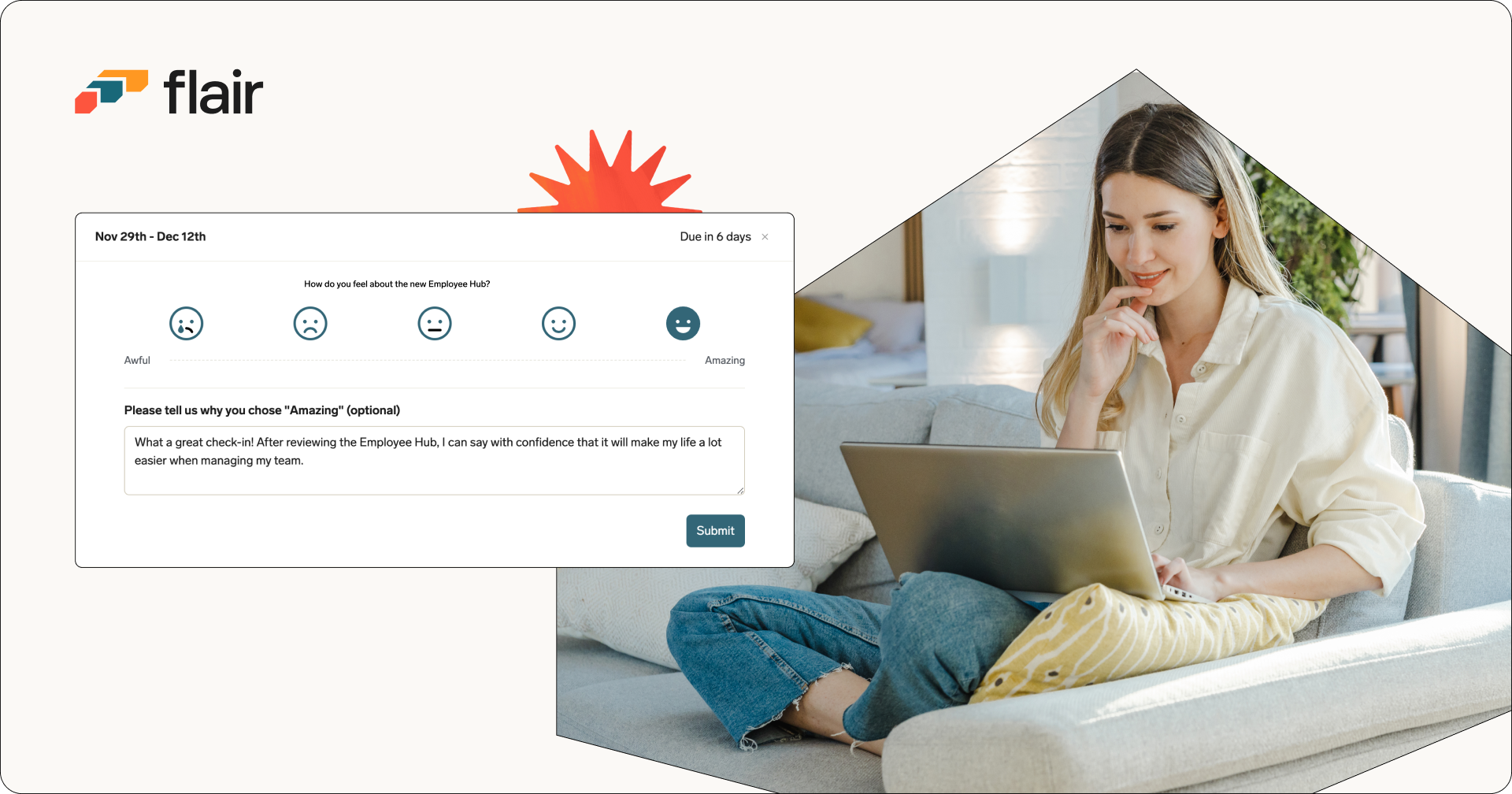Origins to Innovation: Cloud Computing's Impact on HR
Do you know why it's called cloud computing and are you aware of the benefits to HR?
- 06 Jun 2024
- Max 11 min read
The Number One HR Solution on Salesforce
Surveys are a smart way to gain valuable insights into the opinions, perceptions, and experiences of your employees. Looking for a comprehensive rundown on survey benefits and possibilities? Then this blog is for you.
By collecting feedback from employees, employers can uncover important areas of improvement and identify opportunities to enhance employee satisfaction, engagement, and productivity.
In this blog post, we'll explore the many benefits of employee surveys, including how they can help organizations to better understand their employees, improve communication, identify potential areas of risk, and drive positive change. Whether you’re a small business owner or a manager at a large corporation, employee surveys can be a critical component of your talent management strategy. They can help you create a happier, healthier, and more productive workplace for all.
Employee surveys enable companies to better understand their workforce and make informed decisions to enhance employee engagement, productivity, and retention. Workplace surveys also provide employees with the chance to express their opinions and concerns.
Surveys often allow employees to give feedback anonymously and therefore the results tend to be more honest and accurate. Furthermore, the statistics quoted in many blog articles like this are often derived from employee surveys, so where would we be without them?
Employee engagement surveys can cover a range of topics, including job satisfaction, leadership, communication, compensation, benefits, work environment, and company culture. By analyzing employee feedback results, you can gain valuable insights into what motivates employees, what challenges they face, and how to improve the workplace.
Additionally, employee surveys can help companies track progress over time and gauge the impact of certain initiatives and policies.
We’ve touched on some of the gains brought by surveying staff. Let’s delve a little deeper into what employers, human resources, and staff stand to gain from one of our favorite engagement tools, the survey.
Identify improvement areas: Employee surveys allow organizations to gather feedback from their employees on various aspects. This feedback can help employers identify areas that need improvement and implement changes to address any concerns of employees. Want to get the lowdown on the employee experience? Then start with asking questions using surveys.
Measure employee satisfaction: By asking employees about their satisfaction with their job, company, and colleagues, organizations can reach valuable conclusions on the level of engagement within the workforce. This can help employers to identify the drivers of positive sentiment and develop strategies to improve it.
Enhance communication: As people turn to remote work, workplace communication can be a challenge. Managers and staff may not have the same interaction as before. Surveys can help counter that by providing a platform for open conversation and feedback.
Improve collaboration: Employee surveys can also help identify areas where communication and collaboration could be strengthened. For example, if employees indicate that they feel there is a lack of instruction from senior leadership, the organization can take steps to improve communication channels.
Increase employee retention: Employee surveys can be used to identify factors that contribute to employee turnover, such as low morale, lack of recognition, or poor communication. By addressing these issues, organizations can create a more positive work environment and reduce turnover rates.
Boost organizational performance: Employee surveys can provide valuable insights into the strengths and weaknesses of an organization. For example, an exit survey might yield insights into issues with workflow. Likewise, a positive onboarding survey response might show that your company is on the right track when introducing new staff.
Identify areas of risk: Employee surveys can also help companies to identify potential areas of risk, such as worker burnout that impacts mental health, or even discrimination. By identifying these issues early on, organizations can take steps to address them before they escalate.
Empower staff: Surveys provide an opportunity for employees to share their thoughts and opinions about their workplace, their job, and their managers. This can give workers a sense of ownership and boost morale by involving them in the decision-making process. Remember, it’s good to get feedback.

Surveys come in all shapes and sizes. Below is a handy overview to give you an idea of what employee engagement can look like.
eNPS Surveys: An employee net promoter score survey is a great way to measure loyalty and employee sentiment within an organization. The score centers on the likelihood of an employee recommending their company.
Most eNPS surveys focus on a single question like: “On a scale of 0-10, how likely are you to recommend this company as a place to work?” Employees are then divided into three groups based on their responses: Promoters (9-10), Passives (7-8), and Detractors (0-6).
Pulse Surveys: An example of a pulse survey would be the flair Smiley Check-In feature. It allows employees to rate their mood or attitude towards a particular topic using five emoticons. Pulse surveys are short form and they are typically conducted on a regular basis, such as weekly or monthly. They are designed to provide a snapshot of employee attitudes and can be used to identify trends over time. They’re also so quick to complete that employees are more likely to take part.
360-Degree Feedback Surveys: A 360-degree workplace survey involves collecting feedback from multiple sources to determine performance levels. It can involve leadership teams, supervisors, peers, and sometimes even customers or clients.
Employee Engagement Surveys: Employers can identify the factors that drive employee engagement levels, such as job satisfaction, work-life balance, and recognition and rewards. The flair engagement survey allows users to fully customize the layout. Draft engaging survey questions, collect important feedback, and visualize actionable data.
Exit Surveys: As the name suggests, these questionnaires are carried out when an individual leaves or exits a company. They can facilitate honest feedback regarding why employees are leaving and pinpoint what the organization can do to improve retention.
Diversity, Equity, and Inclusion (DEI) Surveys: A DEI survey aims to identify areas for improvement and gather feedback regarding diversity and inclusion. They are a great way to give employees a voice and DEI surveys can bring important data to a complex topic.
Training Needs Assessment: By having a follow-up with staff, employers and human resource teams can pinpoint what skills need developing. A good way to put the wheels of development in motion is by surveying employees’ needs. Training needs assessments can help with skills auditing and professional development.

Here are a few things to consider before creating and communicating a workplace survey.
Goals: The first step in choosing an employee survey is to identify the goals of the survey. What do you want to achieve with the survey? What information do you wish to glean from survey responses?
Metrics: When deciding on the metrics to consider for an employee survey, it’s essential to focus on your organization’s goals and objectives. For example, what is the best way to determine the metric of employee satisfaction or employee morale?
Format: There are many types of surveys. The format chosen will depend on the organization’s goals, the workforce, and the resources available. In truth, as an employer or manager, the way in which you engage with staff is limited only by your own HR capabilities.
Frequency: As with most things, it’s all about timing. How often do you want poll your workforce? Conducting annual surveys allows organizations to obtain timely feedback from employees on their experiences, concerns, and suggestions. The short-format pulse surveys and eNPS lend themselves to more regular use.
Questions: A workplace survey requires careful consideration of several factors. In short, it’s important to choose the right questions that chime with your goals. Make sure to do your research and align survey questions with objectives. It’s also important to keep in mind the importance of anonymity and confidentiality to encourage honest and accurate responses. For example, according to the Harvard Business Review, moving demographic-type questions (about age, education, etc) to the end of an employee survey can increase the response rate by 8%.
Survey Results: Once you’ve gathered the results and survey data, you need to figure out how to make sense of them. Generally, it will be the job of human resource management to collate and visualize survey responses. Once that has happened it’s time to figure out where to take action.
For example, if your survey results indicate that staff are experiencing burnout, perhaps a more coherent organizational structure needs to be put in place. If staff are unhappy with the workplace culture, maybe you can make improvements.
As you can see, employee surveys are an effective way for businesses to gather feedback from their team members, understand employee opinions and experiences, and drive positive company culture changes.
From improving communication and collaboration to increasing employee retention and enhancing organizational performance, the benefits of employee surveys are numerous.
By listening to the feedback of employees and implementing changes based on respondents’ notes, you can build a healthier and more productive work environment.
After all, every organization operates better with happy employees and smooth HR processes. For more information about flair surveys and employee engagement tools, visit our Learning Hub guide here.
Join flair’s newsletter to receive the latest tips & trends in the HR world.

